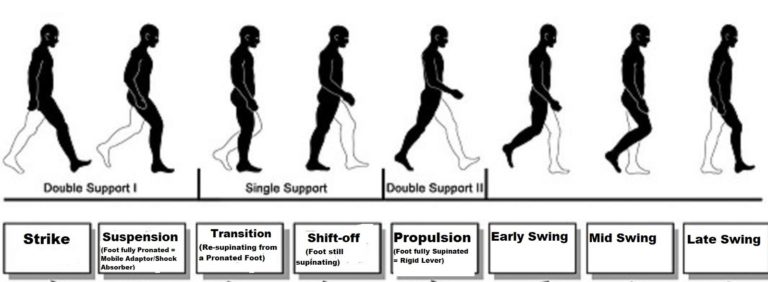In gait (i.e. walking) the 33 joints in each foot take a journey from mobile-adaptor/shock-absorber (suspension phase of gait…much like the suspension in your car) to rigid-lever (propulsion phase of gait). In suspension phase your foot is fully pronated, and in propulsion phase, fully supinated. NOTE: the terms “pronated” and “supinated” are widely misunderstood: both describe a shape of the joints in the entire foot (i.e. both rear and fore-foot) in three dimensions.

Sometimes I feel like most of my work-life is spent helping my clients restore/re-find healthy foot motion to allow the foot to take this journey: pronate – supinate – pronate – supinate…over and over. There are many reasons re-finding foot joint motion creates a healing environment for people stuck in pain, and as an added bonus, often improves performance in athletes:
1) We all know the song “Dem Bones” —
Your foot bone connected to your ankle bone,
Your ankle bone connected to your leg bone,
Your leg bone connected to your knee bone, etc.
The shape of your foot impacts all the way up the chain to your skull (yes, I’ve worked with people who have neck pain where we worked on foot mechanics).
2) If your foot is stuck in pronation or supination, it cannot take the journey. You then miss out on shock absorption. Do you think that your knees/hips/backs, etc. might feel better if your feet participate in shock absorption with every step you take? You also might also miss out on the rigid-lever (supinated foot) for propulsion. Do you think you want to propel the weight of your entire body forward with a non-rigid foot? Believe me, some joint up the chain — often the sacro-iliac joint, an all too common site of pain — will become too rigid to compensate for a non-rigid foot. O.U.C.H.
3) The bottom of your feet have soft tissue that has elastic properties (most well-known is the plantar fascia). Elastic tissues have the ability to stretch and recoil, or store and return mechanical energy:
“The human foot is often described as possessing spring-like qualities during running. The longitudinal arch (LA) of the foot lengthens and lowers (arch compression) during early stance, allowing mechanical energy to be stored in the stretched elastic ligaments and tendons that span this structure. In late stance elastic recoil of these tissues causes the LA to rise and shorten (arch recoil) with stored mechanical energy being returned to the body, contributing positive power for forward propulsion. This mechanism is considered a key contributor to human running economy, delivering an estimated 8–17% of the mechanical energy required for each step” https://www.nature.com/articles/s41598-018-28946-1
If your foot has forgotten how to lengthen and lower the longitudinal arch (i.e. pronate = loading the elastic tissue for recoil), either because it is stuck lengthened and lowered and has no room to further pronate, or because it is stuck in supination, you miss out on that 8-17% mechanical energy. Do you think that might create a potential for over-use of some other joints in the body? Do you think you might be losing some potential efficiency?
Caveat as always: Please do not interpret this post as a call to switch to minimalist shoes overnight. Please do interpret this post as a call to restore the ability of your foot to take the journey from pronation to supination and back over and over and over.
